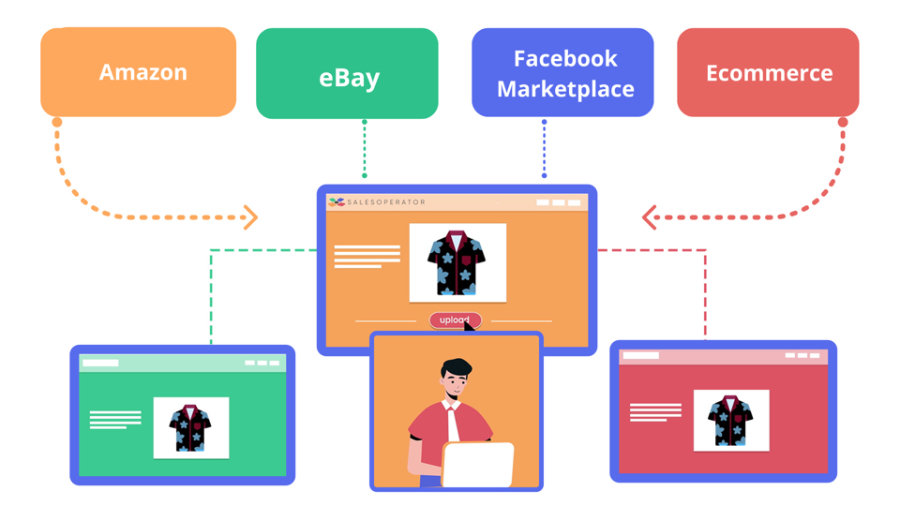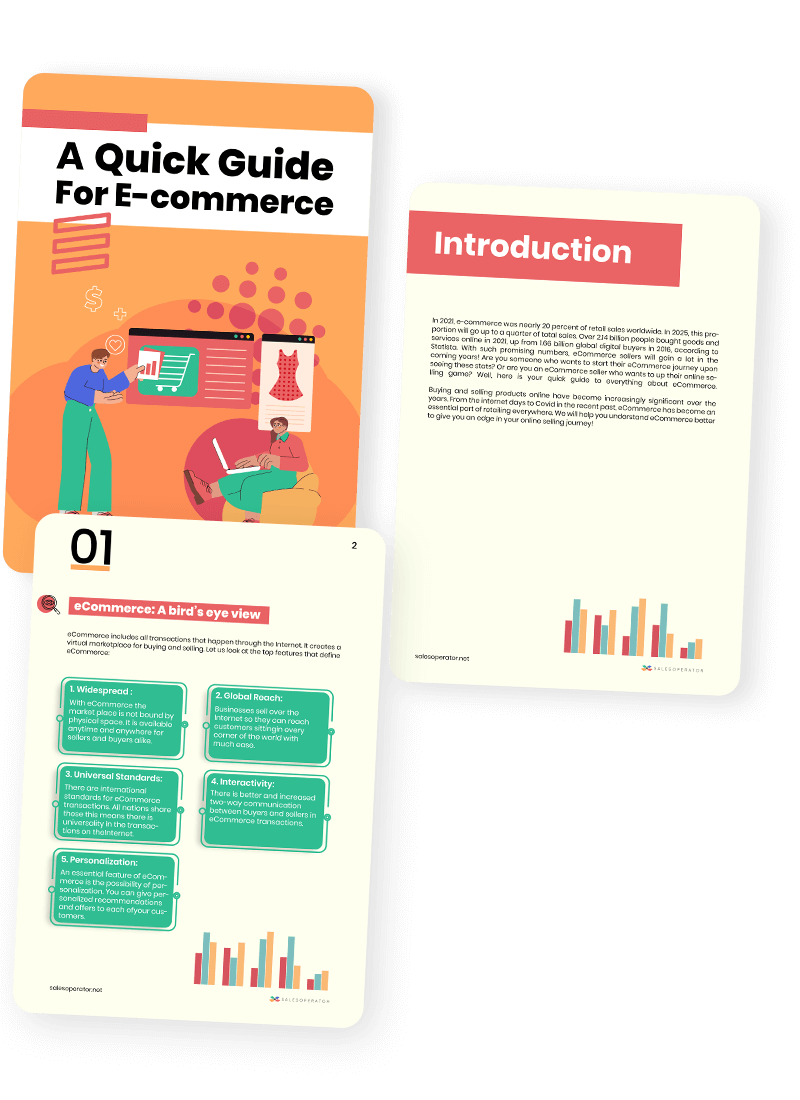The world of eCommerce is going through a phase of tremendous transformation in the digital 2.0 era, especially post-pandemic. As the number of channels increases, making the digital space more cluttered, depending solely on email marketing will not be enough. The reason is simple: your prospect can unsubscribe with a single click.
Nowadays, an average consumer may reach out to you through 3 or more channels. Can you afford to ignore these different channels? Probably, but at the risk of losing your customers to your competitors. Therefore, to win the eCommerce battle, thinking and making multi-channel eCommerce strategies hold a lot of significance for both SMEs and enterprises.
As per the latest study by emarketer forecasts, retailers are already generating $350 billion through multi-channel eCommerce. And it’s only going to go northwards in times to come. It may account for 46% of total eCommerce sales by 2023.
Multi-channel eCommerce: A Brief Introduction
If you’ve exposure to eCommerce, you might have heard about the term—multi-channel eCommerce. It may sound like jargon, but it’s not a complex concept. Many of us have purchased a product after seeing an ad on Facebook, Instagram or Twitter or a third-party sales channel like Amazon or Walmart.
Experienced retailers know that selling on multiple channels is the best way to get their products in front of the largest customer base possible. This enables them to capture a larger market share and help them stand out in a highly crowded and fiercely competitive world of eCommerce. The logic is simple: using multiple eCommerce channels allows an online business to reach a wider audience base, resulting in more sales and revenue.
Increased product visibility on various channels leaves a positive impression of your brand in customers’ minds. A diversified presence helps reduce platform risk as you don’t have to worry about the sudden change in platform policy. That’s an overlooked aspect of the business but a highly critical aspect of business survival.
A Brief Idea About Multichannel Platforms
Before digging deeper, it is imperative to understand briefly various channels that are vital for eCommerce growth:
- Marketplace Platforms: It’s no surprise that most online shoppers begin on Amazon or eBay. They’re two of the largest online marketplaces and present great shoppers opportunities. Then, there are others like Etsy, Walmart and regional marketplaces. These marketplaces provide a great opportunity for sellers. Listing your products on Amazon and eBay can increase your sales by magnitude.
- Social Media: Social channels like Facebook, Instagram and WhatsApp have emerged as powerful channels for eCommerce businesses, and their share in total eCommerce business is constantly increasing. Therefore, ramping up your presence to reach your potential customers makes perfect business sense.
- Comparison Shopping Engines: Many comparison engines like Nextag, Google Shopping or Shopzilla allow selling products. eCommerce players can leverage their power and drive traffic from their sites.
Multi-channel eCommerce Systems: A Game Changer
Though multichannel selling is critical to eCommerce growth, managing these channels can be overwhelming. Using multi-channel eCommerce software can streamline these scattered operations. It helps optimize your eCommerce operations. They allow you to cut down on human error, increase revenue and make better use of your time by cutting down on the number of tasks you have to perform. You can look for solutions associated with certain components of multi-channel eCommerce, such as listing management, workflow automation, inventory management, order management, and other analytics-related solutions. Solutions geared around order fulfillment can help you integrate with multiple eCommerce platforms and ERP systems.

Multichannel systems can save time and effort by allowing you to handle time-consuming tasks, such as uploading listings, setting prices, monitoring stock levels, and doing many more. You can view all vital business metrics on a single dashboard.
Leveraging Multichannel Potential: 7 Things That Can Fuel Growth
Using the following 7 tips can fuel multi-channel eCommerce growth:
Connect and engage through the right channel channels
These are different, and their nature and ecosystems also vary. Each channel requires a different approach. Whether third-party marketplaces or any other social media channel, it makes sense to tailor your brand message and content that suits their ecosystem. What works with Instagram may not work with LinkedIn or Twitter as they cater to different audience segments.
Select the right time to market your product
In today’s fragmented e-commerce landscape, it can seem overwhelming to try and optimize for all channels. That’s why it’s crucial to segment customers and advertise to them based on where they are in the buying process. Focus on reviewing data to optimize ad messaging; create relevant ad types that increase conversion rates, and make sure your brand name is easy to identify in every channel.
Optimize channels
We live in a world of constant change. Keeping a tab on the rapid changes is key to ensuring a strong brand presence in each channel. You must continually assess your channel mix and keep testing your product portfolio to ensure you are maximizing sales and customer affinity on each channel.
Attract & Convert
Getting conversions is incredibly difficult these days. Modern shoppers are accustomed to getting amazing deals on the products they love, but that is expensive. So how do you get around this hurdle? The answer is bundling, which lets you diversify your catalog and expand your offerings without adding warehouse space while also having your customers try new things to find their favorite combinations and discounts. And a great deal can draw more than one customer into your store when they want to try something new. The result? Less cart abandonment and more sales!
Streamline Inventory Operations
Inventory is the lifeblood of any eCommerce business, but inventory management is a complex and resource-consuming process. Managing inventory can be challenging no matter how much you love to shop. Automating your vendor orders, even those that aren’t highly predictable will keep your warehouse cash flow and profitability strong while eliminating waste in your supply chain. Keeping track of your inventory, purchasing it at the right time and optimizing for efficiency and profitability is a challenge for any multichannel seller. A robust inventory management tool can offer a solution tailored to your needs, from real-time visibility with Enterprise Management, order management, forecasting, and more.
You can also think of using a kitting solution as it can effectively enhance your supply chain operation’s efficiency. And kitting products can increase sales and streamline eCommerce fulfillment.
Improve customer experience continuously.
Previously, brands offered red-carpet treatment during special occasions, such as holidays or special days. But today, customers expect a consistent level of treatment every day—and they won’t just buy the first product they see; they actively look for deals and discounts that meet their needs. Therefore, keep working on improving customer experience continuously.
Move towards a personalized experience.
Personalization is key to creating relevant, multichannel journeys. Modern-day shoppers want tailored deals and offerings for themselves, not just generic ones. The ability to be personalized for the customer and deliver relevant, multichannel journeys is at the heart of what e-commerce companies are doing today.
Companies create personalized recommendations for their customers using powerful automation tools and an in-depth understanding of consumer purchasing data. For example, if you are buying a lamp and like the shade that most other customers who purchased the same one selected to go with it, you might be interested that most other customers who bought the same one chose to go with it.
Winning The Game: Designing a Multi-channel eCommerce Marketing Strategy
Many e-commerce businesses are adopting a multi-channel eCommerce marketing strategy. The trick is to stand out by successfully fitting the pieces together for a consistent and satisfactory customer experience by helping them make purchases when, how, and where they want. Important factors and strategies that will significantly improve your chances of your multi-channel eCommerce marketing strategy hitting the bull’s eye are as follows:
- Understand buyers’ journey
Your audience should be at the core of your multi-channel eCommerce strategy. Being well-versed with your customer’s tastes, behavior, traits, and preferences would enable you to tailor your business model and offerings to your target audience.
- Build a marketing plan
An effective marketing plan is built around what consumers want, need, and value. This leads to choosing communication techniques and channels to be employed to engage with the target audience at a more personal level.
- Make prudent use of customer data to audit your product catalogs regularly. This will help you get a better hang of selling products and products that are proving to be a laggard.
- Keep a close tab on search terms that draw buyers to your top-performing products. And if the situation so warrants, do not hesitate to chuck non-performing listings and products altogether.
- Also, it is critical to understand that your catalogs may differ from site to site. Still, the brand focus and consistency should be maintained at all costs through logos, color schemes, content tone, and image styles.
- A well-defined, purposeful CRM plan will help you build and deliver a unified strategy across channels to reach the target audience in the best way. There are multiple channels, and when a prospect connects through a particular channel, the CRM immediately creates a user profile.
Conclusion
The eCommerce market is estimated at around $ 5 trillion. It is expected to grow at 9% per annum for the next five years.
The key to cashing on this tremendous opportunity is putting in motion eCommerce marketing campaigns and strategies spanning multiple channels while keeping channel integration and unified communication in mind. A successful multichannel approach to marketing should entail creating and delivering personalized customer experiences through processes and campaigns to generate qualified leads and increase sales streams, ultimately delivering handsome ROI.




